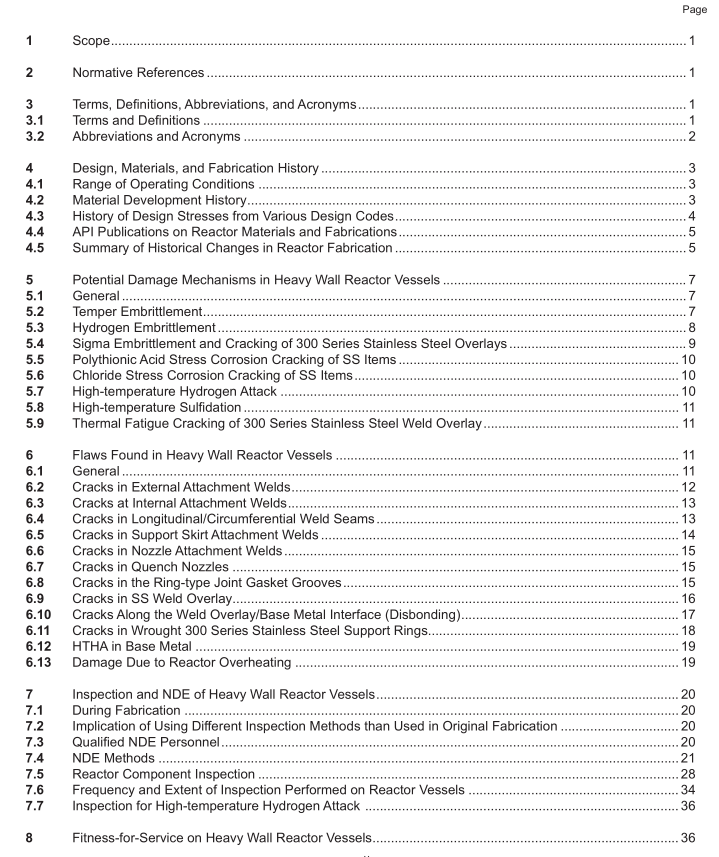API TR 934-H pdf download

API TR 934-H pdf download Inspection, Assessment, and Repair of Heavy Wall Reactor Vessels in High- temperature High-pressure Hydrogen Service
Scope
This TR documents guidance for the inspection, assessment, and repair of heavy wall reactor vessels (nominallyconsidered a wall thickness of 50 mm (2 in.) and greater) in high-pressure hydrogen service operating attemperatures below 455°C(850 °F). t provides industry practices dealing with reactor vessels after constructionand exposure to operating conditions. It focuses on reactor vessels fabricated from 2%Cr-1Mo,3Cr-1Mo, 2%4Cr-1Mo-14V, and 3Cr-1Mo-14V steels. It also offers some guidance for heavy wall reactor vessels fabricated from1Cr-%Mo and 1%Cr-%Mo steels, but specifically does not pertain to C-/%Mo steel vessels.However, guidanceincluded in this document can be used for C-/Mo steel reactor vessels at the owner’s discretion and withmodifications as appropriate.
This document does not address damage found in hot wall catalytic reforming reactors, fluid catalytic crackingunit (FCCU) reactors, and delayed coking drums as they generally operate at higher temperatures and havethinner walls.
Since this is a technical report,it does not provide recommendations, but instead presents industry experiencewith case histories of repairs and recognized practices,much of which was documented as part of a JointIndustry Program (JIP) on Aging Reactor Vessels, conducted in two phases between 1995 and 2004.
2Normative References
There are no normative references in this document.
3Terms, Definitions, Abbreviations, and Acronyms
3.1 Terms and Definitions
For this report, the following terms and definitions apply in addition to those given in APl Recommended Practices934-Aand 934-c.
3.1.1
cladding
Internal integrally bonded corrosion-resistant lining applied as a wrought product to the internal surface of avessel, i.e.the vessel is constructed from clad plate. Clad plate is fabricated using a hot roll bonding process oran explosive bonding process,and is mostly used for thinner wall reactor vessels. See also lining, overlay, andloose lining.
3.1.2
disbonding
Areas of cladding or overlay that do not have a metallurgical bond to the base metal. Disbonding can occurduring fabrication, and testing is typically done to detect and repair any locations. It can also occur due to high-temperature high-pressure hydrogen service depending on the characteristics of the bond areas. Testing ofcladding and overlay procedures are done before fabrication to minimize the susceptibility to disbonding.
3.1.3
J-factor
An empirical relationship used to predict temper embrittlement susceptibility of some low alloy steel grade basematerials
where compositional concentrations are expressed in weight percent.
3.1.4
lining
In this document, an internal layer of higher alloy metallic material applied to a less expensive base metal.Formsof lining include cladding, weld overlay, and loose linings.
3.1.5
loose lining
An internal layer of higher alloy metallic material applied to a less expensive base metal by welding thin sheetsof the high alloy onto the base metal. This leaves a void under the sheets. Other names for these linings includestrip lining and wallpapering.Use of a loose lining typically is not considered acceptable for high-temperaturehigh-pressure hydrogen services.
3.1.6
weld overlay
Aform of metallic lining that is applied using a welding process and metallurgically bonded to the base metal.Seealso cladding, lining, and loose lining.
3.1.7
x-bar
An empirical relationship used to predict temper embrittlement susceptibility of Cr-Mo alloy steel grade weldmaterials and 11/4Cr-1/Mo base metals
X-bar factor = (10 x P + 5 × Sb +4 × Sn + AsW/100
where compositional concentrations are expressed in weight parts per million (wppm).3.2Abbreviations and Acronyms
AUT
automated ultrasonic testing
cuI
corrosion under insulation
DHT
dehydrogenation heat treatment
FCcu
fluid catalytic cracking unit
FFS
fitness-for-service
FMC
full matrix capture
FMR
field metallographic replication
GTAw
gas tungsten arc welding
HAZ
heat-affected zone
HBw
Brinell hardness with tungsten carbide indenter
HTHA
high-temperature hydrogen attack
ISR
intermediate stress relief
ITP
inspection and test plan
LED
light-emitting diode
LMP
Larson-Miller parameter
MDMT
minimum design metal temperature
MT
magnetic particle testing
NDE
nondestructive examination









